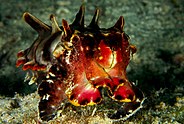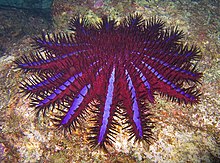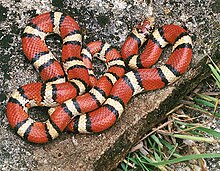警戒作用


警戒作用(英語:Aposematism)是愛德華·巴格諾爾·波爾頓為阿爾弗雷德·拉塞爾·華萊士的警戒色(英語:warning coloration)的概念創造的術語。它是反捕食者適應一類,警告潛在捕食者捕食物無利可圖的信號。[1]無利可圖可包括任何使獵物難吃的防禦,例如毒性、惡臭氣味或強烈反抗的天性。警戒信號有益於捕食者和獵物,因為雙方皆可避免潛在傷害,從而代代遺傳下來。比如在外在特徵方面,警戒作用總涉及顯著的動物色、聲音、氣味或其它可感知特點的廣告信號。
警戒作用利用了苗勒氏擬態,防禦強的物種演化以和其它物種相似。每種物種可以通過模仿類似顏色的物種更低成本更迅速地學習,共享對於捕食者的警告信號。
真正的警戒作用是物種實際有化學或物理防禦,即警戒作用不是威懾捕食者的唯一方法。在貝氏擬態中,模仿物種和一個警戒作用典範緊密相似以分享保護,同時物種多有可以驚嚇掠食者足夠長時間的虛張聲勢的威脅,不設防的獵物趁機逃脫。
防禦機制
[編輯]
警戒作用的功能是通過警告潛在捕食者獵物又例如難吃或有毒的防禦,來預防攻擊。 易檢測到的警告是主要防禦機制,不可見防禦其次。[2]警戒信號主要是視覺的,用明亮顏色和高對比度圖案,例如條紋。警告信號是有毒獵物的誠實徵兆,顯著性隨毒性而演化。[3]因此,生物越亮而顯眼,通常越有毒。[4]這和威脅相反,威脅是以危險的外觀試圖嚇走捕食者,但是虛張聲勢,沒有任何強大防禦支撐。[5]
最常見而有效的顏色是紅、黃、白。[6]這些顏色和綠色植物對比強、抗光影中的改變、高色差,而且提供取決於距離的偽裝.[6]

流行
[編輯]
在陸地生態系統
[編輯]警戒作用普遍存在於昆蟲中,但在脊椎動物中較少,大多局限於少數爬行動物、兩棲動物、魚類、一些惡臭或有侵略性的哺乳動物。林鵙鶲屬,羽毛和皮膚有毒的紅黑色鳥,顯然其毒性來自它們攝取的有毒甲蟲,可以包括在內。[7]

在海洋生態系統
[編輯]
警戒作用在海洋生態系統的存在有爭議。特別是在珊瑚礁的海洋生物,色彩明亮或有圖案的很多,包括海綿、珊瑚、軟體動物和魚類,但很少或沒有和化學或物理防禦有聯繫。雖然加勒比海珊瑚礁海綿色彩繽紛,很多又有化學防禦毒性,但這兩個因素之間沒有明顯關係。[8]

明亮的藍圈章魚有毒。它們大部分時間隱藏在裂縫中,同時用皮膚的色素細胞顯示有效的偽裝圖案。然而,如果刺激了它們,它們迅速改變顏色,在三分之一秒內變為有50-60環閃亮虹彩藍的亮黃色。[9]常有人說這是一種警戒色,[10][11][12][13]該假設很少被驗證過。[14]
理論的起源
[編輯]
華萊士(1867年)
[編輯]波爾頓(1890年)
[編輯]
華萊士於1877年的一篇關於動物色的文章中創造了術語「警戒色」。[15]1890年愛德華·巴格諾爾·波爾頓於其書《動物之色》中重命名該概念為「警戒作用」(aposematism)。[16]他如下描述該術語的來歷:
第二頭(語義上的顏色)包括警戒色和識別標記:前者警告天敵,因此稱之為警告作用的[希臘語,apo,來自,和sema,信號]
演化
[編輯]在演化過程中警戒作用是矛盾的,因為它使個體在捕食者前顯眼,它們可能會被殺死,在捕食者學會避免前特徵消失。如果警戒色最初在有這樣強大缺點的少數個體上,那它將永遠不能在該物種上持續很長時間以成為有利特徵。[17]
支持的解釋
[編輯]備選假設
[編輯]其它皆是是可能的。捕食者可能天生害怕陌生的形態(新奇恐怖症),足夠長時間它們會適應,但通常 是暫時的。[18]
擬態
[編輯]

警戒色是十分成功的策略,在有警戒色和無警戒色物種的進化上影響重大。
參閲
[編輯]注釋
[編輯]- ^ Santos, J.C.; Coloma, Luis A.; Cannatella, D.C. Multiple, recurring origins of aposematism and diet specialization in poison frogs. PNAS October 28, 2003. 2003. doi:10.1073/pnas.100.22.12792.
- ^ Ruxton, G. D.; Sherratt, T. N.; Speed, M. P. Avoiding Attack: The Evolutionary Ecology of Crypsis, Warning Signals and Mimicry. Oxford University Press. 2004. ISBN 0-19-852859-0.
- ^ Maan, M. E.; Cummings, M. E. Poison frog colors are honest signals of toxicity, particularly for bird predators. American Naturalist. 2012, 179 (1): E1–E14. JSTOR 663197. doi:10.1086/663197.
- ^ Blount, Jonathan D.; Speed, Michael P.; Ruxton, Graeme D.; Stephens, Philip A. Warning displays may function as honest signals of toxicity (PDF). Proceedings of the Royal Society B. 2009, 276: 871–877 [2018-03-09]. PMC 2664363
 . PMID 19019790. doi:10.1098/rspb.2008.1407. (原始內容存檔 (PDF)於2018-07-20).
. PMID 19019790. doi:10.1098/rspb.2008.1407. (原始內容存檔 (PDF)於2018-07-20).
- ^ Sendova-Franks, Ana; Scott, Michelle Pellissier. Featured Articles in This Month's Animal Behaviour. Animal Behaviour. 2015, 100: iii–v. doi:10.1016/j.anbehav.2014.12.013.
- ^ 6.0 6.1 Stevens, M.; Ruxton, G. D. Linking the evolution and form of warning colouration in nature. Proceedings of the Royal Society B: Biological Sciences. 2012, 279: 417–426. PMC 3234570
 . PMID 22113031. doi:10.1098/rspb.2011.1932.
. PMID 22113031. doi:10.1098/rspb.2011.1932.
- ^ Dumbacher, J. P.; Beehler, B. M.; Spande, T. F.; Garraffo, H. M.; Daly, J. W. Batrachotoxin in the genus Pitohui: chemical defense in birds?. Science. 1992, 258 (5083): 799–801. PMID 1439786. doi:10.1126/science.1439786.
- ^ Pawlik, JR; et al. Defenses of Caribbean sponges against predatory reef fish: I. Chemical deterrency. Marine Ecology Progress Series. 1995, 127: 183–194. doi:10.3354/meps127183.
- ^ Mäthger, L.M., Bell, G.R., Kuzirian, A.M., Allen, J.J. and Hanlon, R.T. How does the blue-ringed octopus (Hapalochlaena lunulata) flash its blue rings?. The Journal of Experimental Biology. 2012, 215 (21): 3752–3757 [2018-03-09]. PMID 23053367. doi:10.1242/jeb.076869. (原始內容存檔於2018-01-24).
- ^ Williams, B.L., Lovenburg, V., Huffard, C.L. and Caldwell, R.L. Chemical defense in pelagic octopus paralarvae: Tetrodotoxin alone does not protect individual paralarvae of the greater blue-ringed octopus (Hapalochlaena lunulata) from common reef predators. Chemoecology. 2011, 21 (3): 131–141. doi:10.1007/s00049-011-0075-5.
- ^ Huffard, C.L., Saarman, N., Hamilton, H. and Simison, W.B. The evolution of conspicuous facultative mimicry in octopuses: an example of secondary adaptation?. Biological Journal of the Linnean Society. 2010, 101 (1): 68–77. doi:10.1111/j.1095-8312.2010.01484.x.
- ^ Lambert, W.A. A Review of Blue-ringed Octopus Conservation (Masters thesis). Prescott College. 2011.
- ^ Hanlon, R.T.; Messenger, J.B. Cephalopod Behaviour. Cambridge University Press. 1998.
- ^ Umbers, K.D. On the perception, production and function of blue colouration in animals. Journal of Zoology. 2013, 289 (4): 229–242. doi:10.1111/jzo.12001.
- ^ Wallace, Alfred Russel. The Colours of Animals and Plants. I.—The Colours of Animals. Macmillan's Magazine. 1877, 36 (215): 384–408 [2018-03-09]. (原始內容存檔於2019-05-14).
- ^ Marek, Paul. Aposematism. Apheloria. [2012-11-24]. (原始內容存檔於2017-07-08).
- ^ Mappes, Johanna; Marples, Nicola; Endler, John A. The complex business of survival by aposematism. Trends in Ecology and Evolution. 2005, 20 (11): 598–603. doi:10.1016/j.tree.2005.07.011.
- ^ Exernova, Alice; Stys, Pavel; Fucikova, Eva; Vesela, Silvie; Svadova, Katerina; Prokopova, Milena; Jarosik, Vojtech; Fuchs, Roman; Landova, Eva. Avoidance of aposematic prey in European tits (Paridae): learned or innate?. Behavioral Ecology. 2007, 18 (1): 148–156. doi:10.1093/beheco/arl061.
參考文獻
[編輯]- Capinera, John L. (編). Encyclopedia of Entomology 2nd. Springer. 2008 [2018-03-09]. ISBN 978-1-4020-6242-1. (原始內容存檔於2016-06-24).
- Edmunds, M. Defence in Animals. Longman. 1974. ISBN 0-582-44132-3.
- Poulton, Edward Bagnall. The Colours of Animals, their meaning and use, especially considered in the case of insects. London: Kegan Paul, Trench & Trübner. 1890 [2018-03-09]. (原始內容存檔於2018-03-18).
- Ruxton, G. D.; Speed, M. P.; Sherratt, T. N. (2004). Avoiding Attack. The Evolutionary Ecology of Crypsis, Warning Signals and Mimicry. Oxford University Press. ISBN 0-19-852860-4
